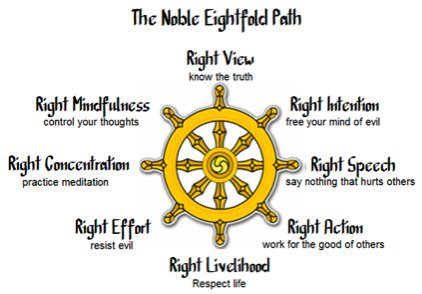The Oldest Self-Help Tool: The Buddha’s Eightfold Path
Most people want to live a happier, more fulfilled life and let go of negative feelings like anger, jealousy, and resentment that are holding them back in life.
The eightfold path is a simple, step-by-step prescription on how to end suffering and achieve freedom in your life. Personally, I use it as a template to live my life by.
It’s even tattooed on my arm.
I’m a work in progress, but I find having something I can refer back to each day really helps me to make sure I’m on the right track.
The best part is that you don’t need to follow Buddhism or subscribe to any particular religion or ideology to incorporate the eightfold path in your life.
What Does the Eightfold Path Mean?
The eightfold path is the fourth noble truth enunciated by the Siddhartha Gautama, better known as the Buddha. Without going into too much detail, this is when the Buddha announced:
Everything in life is suffering
The cause of suffering is clinging
And how do you end clinging and suffering?
You do it by following the eightfold path of Buddhism
A great idea is to print a picture of the eightfold path yourself, stick it up somewhere you’ll see it each day, and try to practice following the path the best you can each day.
Elements of the Eightfold Path – The Prescription
You’ll usually see the eightfold path depicted as a simple list or a kind of wheel (This is known as dharma wheel, one of the most sacred symbols in Buddhism). I even have it tattooed on my arm as a reminder to stay on the right track.
1. Right View (Understanding)
The first thing the Buddha tells us to do to avoid suffering in life is to have the right view. We need to be able to see things for what they really are. It means learning about suffering and karma and the impermanence of the physical world.
These concepts are pretty heavy if you’ve never delved into them before and this could be a whole video on its own. But a good place to start is by picking up a book on Buddhism and exploring these concepts each day.
A book that I highly recommend checking out is Buddhism for Busy People by David Mitchie. It’s an easy read and all of the concepts are related back to real life which is really refreshing.
Since your view of the world forms our thoughts and your actions, the right view helps to develop the right thoughts and right actions.
2. Right Thought (Intention)
Next, he says we need to fill your mind with the right thoughts. Cultivate them. These are thoughts of love, harmlessness, simplicity, and compassion.
The Buddha also said that we also need to let go of any negative or destructive thoughts like anger, cruelty, and violence. It’s all common sense stuff but it’s not something we do enough.
Developing right thought is a lot easier said than done of course. Once you see the catalogue of thoughts you should cultivate, you can run down the list. If it’s not on there, you can say “this doesn’t serve me” and let it go.
3. Right Speech
The next aspect of the path is the right speech. You don’t need me to tell that our words can be used to hurt or help others around us. That’s why the Buddha placed so much emphasis on this aspect of the path.
Our speech should be free of:
Gossip that lacks purpose
Lying
Abuse
Harsh language that could offend or hurt others
Of course, there are exceptions to right speech. For example, sometimes we might need to be harsh with our words to warn someone in danger or we might need to use gossip to gather some important information that could help someone.
Put simply, right speech means you should always try to tell the truth, speak kindly, and choose your words deliberately.
4. Right Action
Next is right action. That means we should try to act in a positive way and avoid acting in a way that harms or deceives others will essentially lead to more suffering for ourselves.
This means avoiding:
Harming others
Stealing
Sexual misconduct. Meaning sexual acts that cause pain to others. Which would be exploiting someone sexually, or cheating on someone in which someone else gets hurt.
Put simply, it means you should act kindly and compassionately, be honest, and respect others. Again these are things which are common sense, but common sense isn’t so common these days.
5. Right Livelihood
We should earn our livelihood in a way that doesn’t harm others.
For example, my profession is in marketing. If I was to make my money by promoting products that support animal cruelty – I wouldn’t be living in a way that is in line with the eightfold path, because I’m indirectly causing the suffering of animals.
Since most of us spend most of our waking our at work, so I feel like this aspect of the path is an important reminder to look at how our work affects our wellbeing, as well as the wellbeing of others.
This is a tough aspect of the path to follow because we all need money to live – especially in the current economic climate. But ultimately, you need to be conscious of how your work impacts those around you.
6. Right Effort
The next aspect on the path is right effort. Right effort means we should be doing everything we can to be the best versions of ourselves possible – both for ourselves and those around us.
What the Buddha is saying here is “Don’t be lazy and sit around the house playing video games and expect to be happy and fulfilled. It’s not gonna happen”.
To develop right effort, start by printing out the eightfold path and living by it each day. Or if another philosophy resonates with you, follow that. Patanjali’s eight-fold path of yoga shares many similarities to the Buddha’s eightfold path and is another great template to follow.
7. Right Mindfulness
Next, the Buddha says we need to cultivate right mindfulness. This simply means being aware and conscious of your mind, body, and the world around you.
You could also put a reminder on your phone to be mindful of what you are doing throughout the day. This is something I’ve just started doing and I find it’s really effective at getting me to take a break from working and really pay attention to my breath, my thoughts, body, and what’s going on in the environment around me.
8. Right Concentration
The last step on the path is right concentration. Right concentration is all about your ability to focus all of your attention on a single object for a sustained period of time.
This could be your breath, a bodily sensation, sounds, a mantra. Anything. Cultivating concentration is an important step in developing mindfulness as it can help to calm the mind at the beginning of longer meditation sessions.
To develop mindfulness I suggest starting with a simple breathing meditation practice (anapanasati). Just sitting with yourself for 10 minutes each day and focusing on the breath is an incredibly effective way to become mindful of your body and thoughts.
Incorporating the Eightfold Path Into Your Life
A great way to start with learning about the eightfold path and Buddhism, and the way that I was inspired to start practicing Buddhism, is to check out the Western Australian Buddhist Society website. You'll find resources such as talks, videos, and podcasts from well known monks from Australia and around the world.
While the eightfold path is easy enough to understand and involves a lot of common sense, Incorporating the eightfold path into your life won’t be easy. It’ll require some effort on your part, especially if you deeply ingrained negative thought patterns or behaviours.
But after some time of focusing on each aspect of the path, you’ll start to notice a positive difference in all areas of your life.
The eightfold path is a way of life that anyone can follow, practice, and cultivate. The path has nothing to do with religion, belief, or prayers. It’s simply a path that anyone can follow to reduce suffering in their lives, and ultimately become the best version of themselves.
You can think of it as self-discipline in the body, word, and mind. It’s one of the oldest and widest used self-help and self-development tools in the world for a reason.
It works.


